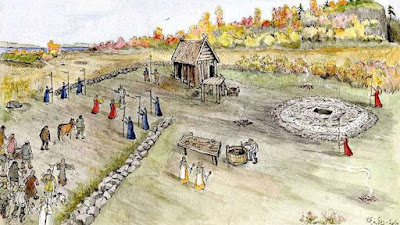Land-taking and Hallowing: Ancient and Modern Traditions
I find it fascinating how many people are really interested in Land-taking and Hallowing rites but know nothing about them. I first read about them in The Tradition of Household Spirits by Claude Lecouteaux, but there are many books that talk about them. There are actually examples of Land-taking and Land Hallowing in the Landnámabók. The basic premise of a Land-taking is to let the landwights know that you are taking stewardship of the land. I say “stewardship” very pointedly. You aren’t just taking the land, you are agreeing to take responsibility for the land. You have to take care of the parcel of land you take. If you don’t you will see the landwights encroaching back into that space. Even so, they may try from time to time.
The most common elements of a land-taking are to walk (usually sunwise) around the boundary (in a process called circumambulation) of the piece of land you wish to take stewardship of and declaring to the wights your intentions to take stewardship of the land. Beyond that, it depends on the source as to what you do within the rite. There is one mention of women walking the boundary of the land leading a cow. It is also indicated that riding a mare around the perimeter could be one way of doing a land-taking. Other sources suggest making loud noises or shouting at the 4 corners of the property, or brandishing torches. My favourite way, personally, is to take some soil from each corner of the property. Then you bring that soil and bury it under your doorstep.
In the Landnámabók it describes the Icelanders as building a series of fires around the perimeter of the property to “lay claim to the land by fire” or else carrying fire around the perimeter. (This is the more common way in modern practice.) Fire is used because it is believed to drive away the wild wights, who are chthonic in nature. Since it was not common for the elder Heathen to lay claim to more land than they could travel across in one day, then the practice was to start the perimeter fires in the East at sunrise and set the perimeter fires in the West at sunset. Therefore, the act of land-taking in this ancient tradition took a whole day. The Icelandic settlers often used poles to mark the boundaries of their properties (usually these were cut poles or staffs stripped of bark, and referred to as landkönnuð, or the settlement mark). If you have ever had your land surveyed and the surveyor flagged it and put stakes in the corners, this is similar to the use of the landkönnuð.
There are also historical instances of flaming arrows being shot to mark the boundaries, throwing a hammer/axe, or the building of cairns. An axe or a hammer might be carved into wood at the boundaries of a property that was claimed by these implements. A ritual to claim a piece of land with an axe described it as taking place at noon, when the axe was thrown first to the East and then to the West. In this instance it was noted that it was not proper to set up a hedge to the North, so the axe was not to be thrown in that direction.
Land-taking and Hallowing are not strictly the same thing, but go hand-in-hand. You must first take stewardship of the land before you can Hallow it, which is to say create sacred space. This can be dedicating a space such as a Vé to the gods or naming a space in dedication to the gods or your ancestors, but at its core, creating sacred space is to create an enclosure, or establish the Innangard. The act of marking the boundaries using fire is part of the act of Hallowing, but only the first step.
Very similar to a Heathen ritual, you first cleanse and ward the space, before you welcome in the gods. The difference is that this space remains sacred until you relinquish your claim, generally before you move. Historically, it would have been common for the land you claimed and Hallowed to be passed down in the family, but in modern times that is not the reality for most families. This does complicate the process based on the kind of property or space you might have as your home. You can Hallow an apartment, for example, despite having no outdoor space, but it will be a different experience to walking the boundaries of a property you own. For an apartment you are only claiming your own space, your unit, and may just walk around with a candle or incense. You will not be claiming any of the common areas, as that doesn’t make sense. Most of your neighbours are probably not Heathen, so it will just get confused.
Now while moving home is not common historically we do have records of this in the Landnámabók, as the settlers to Iceland had to move homes. The records show they often brought with them to their new home important objects, such as the high-seat pillars. It was believed that this allowed the gods to come with them to their new home. Thor and Freyr in particular were seen as associated with the blessing of new homes. The high-seat pillars were often carved with images of these gods.
The elder Heathens did not necessarily create holy space on their land, such as a Vé, but often recognized certain areas as already being holy, such as a waterfall or a grove of trees. If you have a large parcel of land you may consider the natural features that may already be a sacred space that you can use. In addition, the elder Heathens paid heed to the animals they saw on the land and in the air. The animals often would lead them to a sacred space. Pay attention to the animals on your own property, as they may offer you clues as well.
I think we must consider the way in which we move house in the modern times. We usually move into a house already established by someone else, Heathen or not. The elder Heathens would have come to the land and set up boundaries before ever laying down a foundation to build a house, but for most modern Heathens we already have that house when we move in. For this reason we might not hold a land-taking ritual until we have already lived in the house for some time. For the modern Heathen it makes sense to move your Hearth cult, which is to say establish the household, give offerings to your ancestors to bless your new home, and perhaps welcome in a housewight, before looking to your property to lay claim there. You start inwards, then look outwards to the land, then focus inwards again when you Hallow the space. A modern Heathen might own a tract of land on paper but choose to only take stewardship of the portion they intend to cultivate or set up an enclosure upon for their family’s use. If you look at your own property you might note several distinct boundaries, or enclosures, each nested inside the other. At the center is your house, then perhaps a small yard or garden surrounded by a fence or hedge, beyond that you might have a field used for livestock, and then beyond that a wooded/uncultivated land. Of course, not every property will have this many layers, but it illustrates the different pieces that you might do land-takings for or leave to the wild wights.
I, personally, just moved and I have not thought much of setting up a shrine or Vé just yet. Although my property is already entirely fenced it probably makes sense to walk the boundaries anyways, just to make sure. It seems such a different time, when the home can be safe without much worry about outside threats. I don’t need the eyes of the gods immediately to ensure my family’s safety and well-being as my ancestors may well have.
If this post has interested you and you want to know more, I highly recommend the Claude Lecouteux book Demons and Spirits of the Land, as well as all the links and sources below.
Further Reading and Viewing:
Under the Cloak: A Pagan Ritual Turning Point in the Conversion of Iceland by Jon Hnefill Adthalsteinsson
The Tradition of Household Spirits: Ancestral Lore and Practices by Claude Lecouteux
Demons and Spirits of the Land: Ancestral Lore and Practices by Claude Lecouteux
Heathens and Moving
https://www.youtube.com/watch?v=qKPUxxoYCYo
Land Taking
http://odin.heathenthing.org/landtaking.htm
Land-Taking and the Sacral Enclosure
https://larhusfyrnsida.com/land-taking-and-the-sacral-enclosure/ Landtaking and Leavetaking: Rituals for Moving House
https://web.archive.org/web/20050218171926/https://www.medoburg.org/heresies/landtaking.asp Image Source: “Drawing of the place of worship at Ranheim discovered in 2010.” Photo by Preben Rønne, NTNU University Museum.



